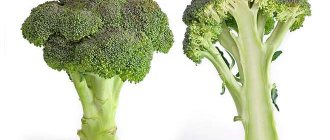How to freeze eggplants for the winter in the freezer at home without spoiling the product is described in detail in our article. The peculiarity of eggplants is that when frozen , their taste and structure change significantly. For this reason, it is important to follow certain rules in this process. It should be noted that when freezing fresh eggplants, it is possible to preserve nutrients in greater quantities compared to canned vegetables, which is a definite advantage.
How to choose the right fruits
Eggplants are selected according to the same rules that are used for canning:
- Pedicel. The color of the fruit's tail should be green. Eggplants whose stems have dried out frozen . Since this indicates that the vegetable was stored for a long time after being picked from the bush;
- Surface quality. The surface of the eggplant should be glossy, there should be no bumps, growths, damage or stains - this fruit is most suitable for freezing;
- Color. It is necessary to choose fruits that are evenly colored;
- Maturity and size. Young best suited for freezing , since large and ripe fruits contain a large number of seeds. Their skin and flesh are tougher.
Advice! To avoid the production of the toxic substance solanine in eggplants, a significant concentration of which is harmful to the health of the body, they should be protected from light during storage. Even a small amount of this component in the vegetable gives it a bitter taste.
When cutting eggplants, popularly known as blue ones, you should pay attention to the color of the cut. Its rapid darkening indicates that the fruit will be bitter, since it contains solanine in large quantities. Light-cut vegetables are more suitable for freezing
Useful tips
Let's summarize all the nuances of freezing and thawing eggplants:
- Be sure to remove bitterness from vegetables by soaking them in salt water. The time depends on the size of the fruit and varies from 30 minutes to several hours.
- Wet vegetables should not be placed in the freezer.
- The tails must be cut off.
- If you freeze cut vegetables, pay attention to the color inside the fruit. If it is dark, it means the fruit is bitter.
- Do not use a microwave or hot water to defrost.
- Vegetables are not re-frozen.
How to freeze eggplants fresh for the winter
When freezing blue ones, you should ensure they are stored airtight. Sliced vegetables are placed in tightly closed packaging, which prevents air from entering the eggplants in the refrigerator. This prevents oxidation of the fruits and the penetration of foreign odors from other products stored in the freezer. This tip, as well as those described below, helps to properly freeze eggplants using any of the proposed methods.
It is easy to ensure the tightness of the package using a vacuum sealer, but you can do without it. At the same time, when freezing vegetables, they use zip bags and ordinary cocktail straws. After placing the vegetables, the bag is closed almost completely, leaving only a small access for a plastic straw. Having inserted it inside the bag, use your mouth to suck the air out of it until the walls of the package stick to the vegetables. Then the tube is carefully removed and the bag is closed completely.
To freeze eggplants at home, you must follow these steps:
- Pre-soak. This stage of fruit preparation should not be abandoned, otherwise bitterness may remain in them, which will make the product unsuitable for consumption. For this reason, before freezing, it is recommended, first of all, to soak the sliced eggplants in a solution of water and salt, after which they must be washed well in clean water;
- Remove moisture. Before placing in the freezer, eggplant should be dried from any water or excess vegetable oil, patted with a paper towel;
- Sign the packaging. In the freezer, plastic containers and bags of vegetables are covered with frost, which makes all the containers look similar to each other, and it is not easy to determine exactly where, for example, eggplants .
Reference! Airtight packaging allows you to store frozen eggplants in the freezer (at a temperature of -12°C) for no more than a year. Exceeding this shelf life negatively affects the taste characteristics of the little blue ones.
Important! It is better to freeze eggplants in portions, as much as you need at a time. Otherwise, when repeatedly frozen and defrosted, they lose their taste and beneficial elements.
General rules for freezing eggplants
Each method has its own characteristics, but regardless of its type, you need to follow some simple rules. They are as follows:
- For storage, use sealed plastic or plastic bags with zippers, containers with tight lids. Fruits perfectly absorb foreign odors, so when stored in unsealed containers they will develop a foreign taste;
- It is better to freeze vegetables at a temperature of at least -12 ºС, this is the only way they will retain their beneficial qualities and taste;
- maximum shelf life is 6 months;
- It is not advisable to store blue ones together with other vegetables; if you like vegetable stew and other mixtures, add vegetables as you prepare the dish;
- As soon as you have defrosted the vegetables, drain all the water from them and dry them on a towel.
On a note! When you make vegetable preparations for the winter, be sure to label the container: put the date and sign the name of the contents. This way you can quickly find the product you need and can control the shelf life.
Options for processing eggplants for freezing
Frying
Is it possible to freeze fried eggplants for the winter ? Yes.
- Wash the eggplants, cut into slices up to 0.7 cm thick. If you cut them thinner, during frying the pieces will become even smaller and will not be suitable for freezing in the freezer;
- To get rid of bitterness, vegetables should be salted and waited for about 30 minutes. Then rinse with clean water;
- Place the pieces on the grill, baking sheet or other similar surface and leave to dry. To speed up the process, you can pat the eggplant with a paper towel;
- Add a little vegetable oil to a hot frying pan and lightly fry the eggplant for a few minutes on each side. Stop frying the pieces when they have a light golden crust;
- Place the eggplant on a wire rack, cool to room temperature and place in the refrigerator compartment to freeze at a temperature below -12˚C;
- After 90 minutes the eggplants from the freezer, remove them from the wire rack and pack them into bags, again placing them in the freezer, where they are stored until use;
- Place stickers on bags of eggplants, indicating the name, weight and method used to prepare the product for freezing;
- You can cut the blue ones into cubes or bars, depending on your plans for preparing dishes after defrosting the vegetables.
Baking
- Cut the eggplants into circles or slices, which are great for later preparing rolls;
- Preheat the oven until the temperature reaches 180˚C;
- Place the blue ones on a baking sheet greased with vegetable oil and put them in the oven for half an hour;
- After a quarter of an hour, turn the pieces over so that both sides of the sliced eggplants are baked;
- Then repeat the same steps as indicated for fried eggplants: dry, place in the freezer for 30 minutes, pack into packages as much as is needed for 1 time, ensure the seal is sealed inside them, stick stickers, and then store in the freezer until use.
Extinguishing
- Add a small amount of vegetable oil to the saucepan and heat it;
- Place the eggplant and, stirring from time to time, simmer the vegetables until tender; you can add salt and pepper to taste;
- Remove from heat and cool to room temperature;
- Transfer the stewed eggplants into bags or containers and place them in the freezer freeze
Blanching
- Pour water into a saucepan, boil, salt well and add 1 tbsp. a spoonful of lemon juice (you can squeeze fresh juice from half the fruit);
- Boil eggplant pieces
- Remove the vegetables with a slotted spoon and immediately plunge into ice water;
- Remove and dry the eggplants;
- After this, the blue ones can be frozen.
Cooking
- Cut off the tails of the fruits, pierce the eggplants with a needle or toothpick;
- Soak the vegetables for 45 minutes in a solution of table salt, removing the bitterness; such a long time is necessary due to the fact that the processing of blue vegetables is carried out in a whole, uncrushed form;
- the eggplants in it for 20 minutes from which the bitterness has previously been removed;
- During boiling, vegetables shrink, they should be cooled and chopped using any convenient method, after which the product is ready for freezing.
Freezing the whole fruit
- Eggplants are exposed to high temperatures without peeling. To do this, whole vegetables can be stewed in a slow cooker, baked on the grill, or boiled using the method described above;
- Then cool the blue ones and dry the moisture from their surface with a paper towel;
- Carefully wrap the vegetables separately in a thick layer of cling film and place in the freezer.
Advice! You can freeze whole eggplant fruits by preserving the skin or peeling the vegetables, depending on the form in which they will be eaten.
Blanks for rolls
It is incredibly convenient to prepare frozen eggplant using special preparations. For this:
- Wash and dry the vegetables without peeling them;
- Remove the stems, cut the eggplants lengthwise into long slices 5-8 mm thick;
- Place in a container of suitable size, salting each layer;
- Leave for half an hour, then rinse well in clean water and dry;
- Place the eggplant in one layer on baking paper, which is used to cover a baking sheet, and bake in the oven at 200˚C for about 15 minutes;
- Eggplants should definitely be baked in one layer, if necessary in several batches;
- Then take out the baking sheet and cool the vegetables;
- Spread cling film on a tray, arrange the eggplant in one layer, if necessary, place many layers, cover each layer on top using film, and then freeze the pieces for several hours;
- Then take out the blanks and place them in bags or containers, getting rid of the film.
How to freeze eggplants and zucchini
Zucchini, by analogy with eggplant, is recommended to be small in size - the pulp of such fruits contains fewer seeds. There should be no damage to the surface of the peel. It is permissible to freeze prepared vegetables immediately - in portions, but then it will be necessary to lay parchment between the layers so that the pieces do not freeze.
Ingredients:
- eggplants – 500 g;
- zucchini – 500 g;
- water – 1 l;
- salt – 1 tbsp. l.
Recipe:
- Cut thoroughly washed vegetables as desired - into strips, cubes, slices or circles. The thickness of each slice should not exceed 1 cm.
- The little blue ones are soaked in a saline solution, dried together with the zucchini - this will prevent them from freezing into a lump.
- Cool the slices by distributing them in one layer on a baking sheet, tray or cutting board, and only then pack them into a common bag or other container.
To simplify and speed up preparation, you can use small bags in which zucchini and eggplants will be frozen. In this option, the vegetables are distributed in a thin, even layer - no more than 1.5-2 cm. But each such bag should contain such a volume of zucchini-eggplant mixture that can be used at one time. The vegetable mixture cannot be re-cooled after thawing.
On a note!
To cool zucchini and eggplant, it is recommended to use a freezer with a blast freezing mode - this will preserve the cellular structure of the vegetables.
Defrosting rules
freeze vegetables no more than once. Therefore, re- freezing eggplants after thawing is prohibited. For this reason, it is necessary to properly distribute the portions of blueberries in packages before placing them in the freezer. In this case, you can easily use the amount of vegetables that is required in each specific situation. The following are the ways to use the product:
- To defrost eggplants, you can simply remove them from the freezer, place them on a large plate and leave them to defrost at room temperature without using any auxiliary electrical appliances;
- To prepare some dishes, you do not need to defrost vegetables; in this case, you can start frying or boiling eggplants immediately after they are taken out of the freezer.
Watch the video! How to properly freeze eggplants for the winter
How to defrost eggplants correctly (briefly)
The workpiece can be defrosted in any available way, except for one thing: it cannot be immersed in water from the freezer. The result will be achieved - the vegetable will defrost, but at the same time it will be saturated with a large amount of liquid and will become unsuitable for cooking.
If you don’t have time to wait, and the workpiece is already cut correctly, you can throw it frozen into the pan, and everything will defrost during the preparation of the main dish. Thawing time for whole fruits at room temperature is 2 hours.
Frozen Eggplant Recipes
Eggplant caviar
We will need:
- 1 kg of eggplants;
- 3 onions;
- 3 carrots;
- 70 ml sunflower oil;
- Salt, pepper, spices to taste.
How to cook:
- fry onions and carrots;
- add thawed eggplants, cut into cubes, salt, pepper, season with spices;
- simmer, when the dish is almost ready, add a little chopped garlic;
Potatoes fried with blueberries
We will need:
- 0.5 kg eggplants;
- 2 onions;
- 0.5 potatoes;
- 70 ml sunflower oil;
- 2 cloves of garlic;
- Salt, pepper, spices to taste.
How to cook:
- fry onions with potatoes and eggplants, cut into cubes or circles, in different frying pans;
- after that, mix the ingredients and fry a little more, adding a small amount of garlic, spices and herbs.
Eggplant rolls
- defrost the blue “tongues”, put the filling on top to taste, place in a baking dish;
- grate the cheese and sprinkle it over the eggplant pieces, bake in the oven until the dish is ready.
Vegetable stew
We will need:
- 0.5 kg eggplants;
- 3 onions;
- 3 carrots;
- 3 bell peppers;
- 2 tomatoes;
- 70 ml sunflower oil;
- 2 cloves of garlic;
- 100 g cheese (Dutch, Russian)
- Salt, pepper, spices to taste.
How to cook:
- defrost and fry the eggplants, add chopped vegetables to taste, the dish can be prepared using onions, carrots, bell peppers;
- simmer, when the stew is almost ready, you can add an arbitrary amount of chopped tomatoes, garlic, seasonings and herbs, if desired;
- grate the cheese, sprinkle it on the dish and let the cheese melt under the lid.
Buckwheat porridge with eggplant
We will need:
- 500 g buckwheat porridge
- 0.3 kg eggplants;
- 2 onions;
- 50 g butter;
- Salt, pepper, spices to taste.
How to cook:
- boil buckwheat, 2-3 hard-boiled eggs;
- fry onions with eggplants;
- add butter, chopped eggs, fried vegetables to the porridge, season with spices and herbs as desired.
Casserole with meat and eggplant
We will need:
- 250 g of any minced meat (chicken, pork, beef);
- 500 g eggplants;
- 50 ml sunflower oil;
- salt, pepper, spices to taste.
- 1 raw egg;
- 200 ml milk;
- 2 tomatoes;
- 150 g cheese (Dutch, Russian);
- 2 cloves of garlic.
How to cook:
- take a little minced meat from any meat, a couple of cloves of garlic, a raw egg, salt, season with pepper and other spices, mix all the ingredients;
- distribute the mixture over the baking dish and a little on its sides, put eggplants on top, which must first be thawed and fried;
- Place the tomatoes cut into slices on them, beat an egg, add milk to it, pour the mixture into a mold, grate the cheese, sprinkle it on the dish and bake in the oven.
Eggplant paste with nuts
We will need:
- 500 g eggplants;
- 50 ml sunflower oil;
- salt, pepper, spices to taste.
- 1 teaspoon vinegar;
- 3 tbsp. spoons of walnuts;
- 2 cloves of garlic.
How to cook:
- defrost vegetables, fry them with vegetable oil, mash with a fork;
- add vinegar, some walnuts and garlic, which have previously been chopped;
- season with cilantro and other herbs if desired, stir and garnish with pomegranate seeds.
eggplants turn out to be very appetizing there are also many recipes for delicious salads with blueberries.
Useful properties of the product
Eggplants, fresh and frozen, are rich in substances beneficial to human health:
- vitamins C and group B;
- microelements (calcium, phosphorus, potassium);
- pectin and fiber.
The vitamins that make up the vegetable are not very diverse, but eggplants are known for their low calorie content and pectin content, which improves the functioning of the digestive system and helps remove bile and excess cholesterol. Potassium rids the body of excess fluid and normalizes the functioning of the cardiovascular system. For these purposes, it is especially useful to consume baked or stewed fruits. Eggplants help prevent diseases such as atherosclerosis, anemia, osteoporosis, osteochondrosis, and gout.
Reference! Due to the content of vitamin PP (niacin) in eggplants, they help fight nicotine addiction, alleviating the symptoms of “nicotine starvation.”
The use of frozen eggplants is not fundamentally different from the use of fresh ones. However, the taste of the latter is more expressive and strong. For this reason, it is easier to prepare an appetizing dish from fresh, high-quality vegetables purchased in a store or market. And if this is not possible, frozen eggplants can be an excellent option to diversify your diet.
Watch the video! Freezing eggplants for the winter
Let's sum it up
Eggplants can and should be frozen. They retain 80% of their beneficial properties and do not lose their taste. The exception is fresh eggplants that have not undergone preliminary heat treatment. The most popular processing methods are frying, boiling, stewing. Before processing, in any case, it is necessary to soak the fruits in salt water. This way the bitterness will disappear from them. It is better to store frozen vegetables without “neighbors”, in an airtight container. Defrosting is not necessary before cooking. Frozen eggplants serve as an excellent addition to potatoes, meat dishes and as a component of vegetable salad.
Have a good harvest and bon appetit!
Making preparations for the winter is practical. The presence of spacious freezers allows you to prepare frozen vegetables. For example, you can freeze eggplants for the winter. In winter, these vegetables are expensive, so prepared preparations will help significantly save the family budget.











